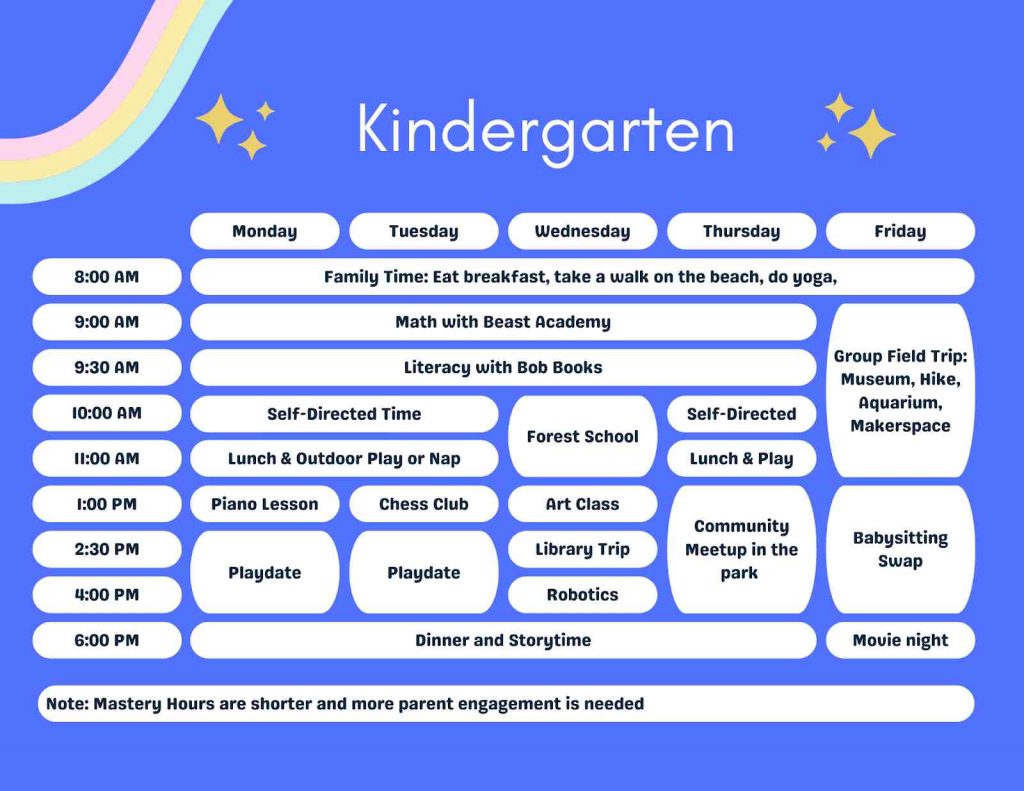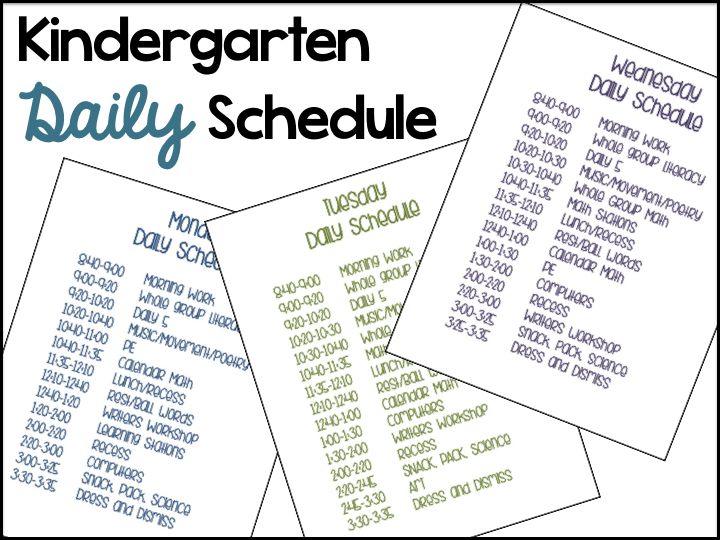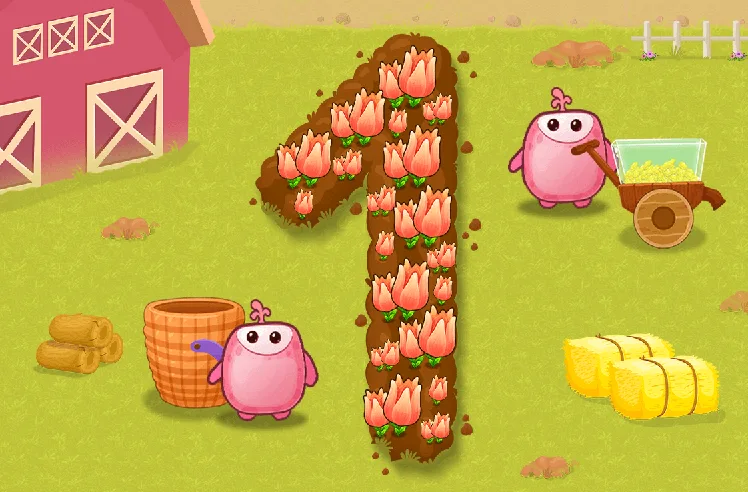Ever wondered how to make your mornings less chaotic and more productive with your little one? A structured schedule for kindergarten kids can be a game-changer. Not only does it help in organizing the day, but it also fosters a sense of routine and security for your child. In this blog, we’ll explore why you need a schedule for your kindergartener and how to create one that works for your family.
Math & ELA | PreK To Grade 5
Kids see fun.
You see real learning outcomes.
Watch your kids fall in love with math & reading through our scientifically designed curriculum.
Parents, try for free Teachers, use for free
Why Do I Need a Schedule for My Kindergartener?
- Creates a stable routine: A kindergarten schedule establishes a consistent daily routine, which helps your child know what to expect each day. This stability can reduce anxiety and make transitions smoother.
- Promotes better sleep: Regular kindergarten times help regulate your child’s internal clock, leading to better sleep patterns. When bedtime and wake-up times are consistent, kids tend to sleep more soundly and wake up more refreshed.
- Enhances learning: A structured daily kindergarten schedule includes dedicated times for learning activities, which can boost your child’s cognitive development and academic skills. Knowing when it’s time to learn helps children focus better.
- Encourages good behavior: When children know what to expect, they are less likely to act out. A predictable schedule reduces the uncertainty that can lead to tantrums and misbehavior.
- Encourages independence: Following a daily schedule helps children learn to manage their time and tasks independently. This can build confidence and self-discipline as they take ownership of their routines.
How to Create a Structured Schedule for Kindergarten Kids
1. Assess your child’s needs: Start by understanding your child’s individual needs and personality. Every child is unique, so what works for one might not work for another. Pay attention to when your child is most alert and when they need rest. This will help you design daily routines for kindergarten that fit your child’s natural rhythm.
2. Plan for balance: A full day kindergarten schedule should include a mix of learning, play, meals, and rest. Balance is key to keeping your child engaged and happy. Make sure there are periods for focused activities like reading or counting, and equally important, times for free play and outdoor activities. This balance helps in overall development and prevents burnout.
3. Be consistent, yet flexible: Consistency helps children feel secure, but it’s also important to be flexible. Life can be unpredictable, so while it’s crucial to stick to the timetable as much as possible, be prepared to make adjustments. Flexibility ensures that changes or unexpected events don’t cause stress for you or your child.
4. Include breaks and quiet time: Young children have shorter attention spans, so including regular breaks in the schedule is essential. These breaks can be short, like five minutes of stretching or a quick snack. Additionally, incorporate quiet time where your child can rest or engage in calm activities like reading or puzzles.
5. Visual schedules: Use visual aids to help your child understand and follow the schedule. A visual full day kindergarten timetable can include pictures for different activities like eating, playing, and napping. This not only makes it easier for your child to follow but also adds an element of fun to the routine.
6. Communicate and adjust: Regularly talk to your child about their schedule and be open to making changes based on their feedback. If a particular activity or time isn’t working, don’t hesitate to adjust. The goal is to create a daily routine that works best for both you and your child.
Kindergarten Schedule Sample

Creating a kindergarten schedule that works for your child can make a big difference in their day. Here’s a sample schedule to help you get started. This kindergarten daily schedule template includes a balance of learning, play, and rest to keep your child engaged and happy.
1. Morning Routine
- 7:00 AM – Wake Up and Breakfast: Start the day with a nutritious breakfast to fuel your child for the day ahead.
- 8:00 AM – Morning Circle Time: This is a great time for a brief discussion about the day’s activities and any special plans.
- 8:30 AM – Learning Activities: Focus on educational activities such as reading, counting, or letter recognition. Use interactive books and games to make learning fun.
If you are looking for learning activities to fit into your child’s schedule, here are some fun games that you can check out:
2. Mid-Morning Routine
- 9:30 AM – Snack Break: A healthy snack gives your child the energy to keep going.
- 10:00 AM – Outdoor Play: Allow your child to play outside. Physical activity is crucial for their development and helps them burn off some energy.
- 11:00 AM – Creative Time: Engage in activities like drawing, painting, or crafting. This nurtures creativity and fine motor skills.
Explore these fun art & creativity games for your kindergartener that are mess free can easily fit into their schedule and make screen time productive:
3. Midday Routine
- 12:00 PM – Lunch: A balanced lunch to keep your child nourished.
- 12:30 PM – Quiet Time/Rest: Whether it’s naptime or just some quiet reading, this is important for recharging.
4. Afternoon Routine
- 1:30 PM – Educational Screen Time: Use screen time for educational games that reinforce what they’re learning in their kindergarten class schedules. Look for apps that are fun and educational.
Here are some fun educational games that align with the academic skills that your child needs:
- 2:00 PM – Story Time: Reading together can be a great way to wind down and promote a love of books. To get your child into the habit of reading, you need books that are perfect for their level. If not, your child may feel overwhelmed and lose interest. With SplashLearn, you get 100s of books aligned to your child’s reading proficiency, and you can track their progress. Here’s what you can access at SplashLearn:
- Leveled Readers: Books designed to match kids’ reading skills at different levels. Children can progress to more challenging books as they improve.
- Decodable Books: Perfect for beginners, these books help children practice phonics and sound out words independently, building confidence and foundational skills.
- 2:30 PM – Hands-On Learning: Activities like puzzles, building blocks, or science experiments can be very engaging and educational.
Related Reading: Best Hand-On Activities for Kids
5. Late Afternoon Routine
- 3:30 PM – Free Play: Let your child choose their activity. This unstructured time is vital for creativity and independence.
- 4:30 PM – Snack Break: Another healthy snack to keep up energy levels.
- 5:00 PM – Family Time: Spend some quality time together. This can include talking about the day, playing a game, or simply relaxing.
6. Evening Routine
- 6:00 PM – Dinner: A nutritious dinner to end the day.
- 6:30 PM – Bath Time: Getting ready for bed with a warm bath.
- 7:00 PM – Bedtime Story and Sleep: End the day with a bedtime story to calm your child and prepare them for a good night’s sleep.
For those who prefer a half day kindergarten schedule, focus on condensing the key activities into a shorter time frame, ensuring you still cover the essentials of learning, play, and rest.
By using this kindergarten daily schedule template, you can create a structured and enjoyable day for your child, making sure they get the most out of their kindergarten experience.
3 Tips for Staying Flexible with a Kindergarten Schedule
1. Adapting to Changes
Life is full of surprises, and it’s important to stay flexible with your kindergarten schedule. Here are some tips:
- Stay calm: When unexpected events occur, stay calm and adjust the schedule without stress. Explain the changes to your child in a simple way.
- Prioritize: Identify which activities are essential and which can be rescheduled. Focus on maintaining key parts of the routine like meal times and naps.
- Backup plans: Have backup activities ready. For example, if outdoor play is canceled due to weather, have indoor games or crafts available.
2. Listening to Your Child
Your child’s feedback is crucial in making the schedule work. Here’s how to incorporate it:
- Regular check-ins: Ask your child how they feel about their daily routines. Are there activities they enjoy more or less?
- Be observant: Pay attention to signs of boredom or frustration. Adjust the schedule to include more engaging or relaxing activities as needed.
- Flexibility: Be willing to change the schedule based on your child’s energy levels and interests. This keeps them motivated and happy.
3. Seasonal Adjustments
As seasons change, so should your schedule for kindergarten kids. Here’s how to adapt:
- Outdoor activities: In warmer months, include more outdoor playtime. In colder months, focus on indoor activities like crafts and reading.
- Holiday adjustments: During holidays or special occasions, modify the schedule to include festive activities and family time.
- Daylight changes: Adjust the timing of activities based on daylight hours to make the most of natural light for play and learning.
Related Reading: How to Prepare Your Child for Kindergarten
Conclusion
Creating a schedule for kindergarten kids helps establish a routine that supports their growth and development. By balancing learning, play, and rest, you can make each day productive and enjoyable. Use the tips and resources to tailor a schedule that fits your child’s needs and keeps them engaged. Start today and see the positive impact on your child’s daily life.
Related Reading: Simple After School Schedule for Kids of All Ages
Frequently Asked Questions (FAQs)
How can I make the kindergarten schedule more engaging for my child?
To make the schedule more engaging, include a variety of activities that cater to your child’s interests, such as interactive educational games, hands-on projects, and plenty of outdoor play. Regularly switch up activities to keep things fresh and exciting.
How do I handle transitions between activities in the schedule?
Smooth transitions can be managed by giving your child a heads-up before changing activities, using visual or auditory cues like timers or songs, and keeping transition times consistent. Establishing a predictable routine helps children know what to expect next.
What do kids do all day in kindergarten?
Kids in kindergarten engage in a mix of activities, including learning basic literacy and math skills, playing indoors and outdoors, participating in creative arts and crafts, and enjoying storytime and quiet rest periods.
What are the three basic kindergarten kids schedules?
The three basic kindergarten schedules are full-day, half-day, and alternate-day schedules. Full-day involves a complete day of activities, half-day includes morning or afternoon sessions, and alternate-day schedules have children attending every other day.




































